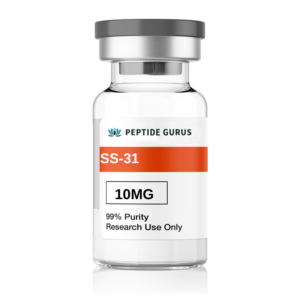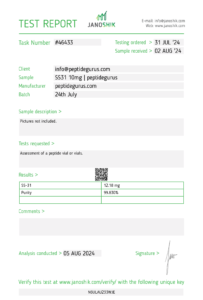In the realm of medical research, mitochondrial diseases pose a significant challenge due to their complex nature and the limited treatment options available. SS-31, also known as Elamipretide, has emerged as a promising peptide in the treatment of mitochondrial diseases. This article delves into how our high – quality
SS – 31 peptide can contribute to this crucial area of research.
Mitochondria are often referred to as the “powerhouses” of our cells. They are responsible for producing the majority of the energy our cells need to function properly, in the form of adenosine triphosphate (ATP). Mitochondrial diseases occur when there are problems with the mitochondria’s ability to generate energy. These diseases can affect various organs and systems in the body, especially those with high energy demands such as the brain, heart, muscles, and kidneys.
Symptoms of mitochondrial diseases can vary widely but commonly include fatigue, muscle weakness, exercise intolerance, vision and hearing problems, and neurological issues. There are many types of mitochondrial diseases, some are inherited, like mitochondrial myopathy and Leber’s hereditary optic neuropathy (LHON), while others can be caused by factors such as ischemia – reperfusion injury.
SS – 31 is a small, aromatic peptide with a unique sequence of D – Arg – Tyr(2,6 – diMe) – Lys – Phe. Its molecular formula is , and it has a molecular weight of 639.8 g/mol. This peptide has the remarkable ability to easily penetrate cell and organelle membranes, specifically targeting the mitochondria.
Once inside the mitochondria, SS – 31 stabilizes an enzyme called cardiolipin, which is a fundamental component of the inner mitochondrial membrane. Cardiolipin plays a crucial role in the electron transport chain, the process by which mitochondria produce ATP. By stabilizing cardiolipin, SS – 31 helps maintain the integrity of the electron transport chain, reducing the production of reactive oxygen species (ROS), also known as free radicals. ROS can cause damage to cells and contribute to the progression of mitochondrial diseases. In addition, SS – 31 may have other mechanisms of action that are still being investigated, such as interacting with other mitochondrial proteins to further enhance mitochondrial function.
In pre – clinical studies, SS – 31 has shown great promise. For example, in animal models of mitochondrial diseases, such as rats with ischemia – reperfusion injury of the kidney, SS – 31 treatment protected the kidney structure, accelerated the recovery of ATP production, and reduced cell death and necrosis. In mice, it was found to interact with cardiolipin in the inner mitochondrial membrane and reduce symptoms of mitochondrial disease regardless of the cause.
In human clinical trials, the results have been a mixed bag so far. Phase II trials showed some encouraging outcomes. For instance, SS – 31 increased exercise performance after just 5 days of treatment and had no major safety concerns or prominent side effects. However, phase III trials failed to produce conclusive evidence of its clinical utility. But many experts believe that this may be due to the endpoints chosen for the trials rather than the peptide itself being ineffective. There are ongoing phase II trials and planned phase III trials with different outcome measures to further evaluate the effectiveness of SS – 31 in treating mitochondrial diseases.
Our SS – 31 peptide is of the highest quality, with a purity of 99.830%. This high – purity peptide is essential for reliable research and potential future treatments. It is available in a 10mg dosage form, which is a common and convenient amount for research purposes.
Proper storage and handling of our SS – 31 peptide are crucial to maintain its integrity. The peptide should be stored according to the recommended conditions, which typically involve refrigeration to prevent degradation. When handling the peptide, researchers should follow strict laboratory protocols. This includes using sterile equipment to avoid contamination, as any impurities can affect the results of research studies.
The U.S. Food and Drug Administration (FDA) plays a vital role in regulating the development and approval of new treatments, including those for mitochondrial diseases. As of now, SS – 31 has not been fully approved by the FDA for the treatment of mitochondrial diseases. However, it has been granted orphan drug status, which is given to drugs that treat rare diseases like many mitochondrial disorders. This status provides incentives for further research and development.
Researchers using our SS – 31 peptide for mitochondrial disease treatment research must adhere to FDA guidelines. These guidelines require comprehensive pre – clinical and clinical studies to establish the safety and efficacy of the peptide. Pre – clinical studies should involve in – vitro tests to understand how SS – 31 interacts with mitochondria and cells, as well as in – vivo animal studies to evaluate its effects on mitochondrial disease models. Clinical trials in humans must follow strict protocols to ensure the safety of participants and the accuracy of the data collected.
No, you should not use the SS – 31 peptide on your own. It is currently intended for research purposes only and has not been fully approved for clinical use. Self – treatment can be dangerous and is not recommended. Mitochondrial diseases are complex, and any treatment should be carried out under the supervision of a healthcare professional in a regulated clinical setting.
In clinical trials, SS – 31 has generally been well – tolerated. However, some people may experience mild side effects such as redness or swelling at the injection site. More severe side effects are rare but possible. Since SS – 31 affects mitochondrial function, in theory, it could potentially cause problems with energy production in some individuals, but this has not been widely reported. It’s important to note that side effects can vary from person to person, and any concerns should be discussed with a healthcare provider.
The time it takes for SS – 31 to show effects can vary. In some phase II clinical trials, an increase in exercise performance was seen after just 5 days of treatment. However, for more comprehensive improvements in mitochondrial disease symptoms, it may take longer, potentially weeks to months of continuous treatment. The response also depends on the type and severity of the mitochondrial disease, as well as individual factors such as a person’s overall health and genetic makeup.

